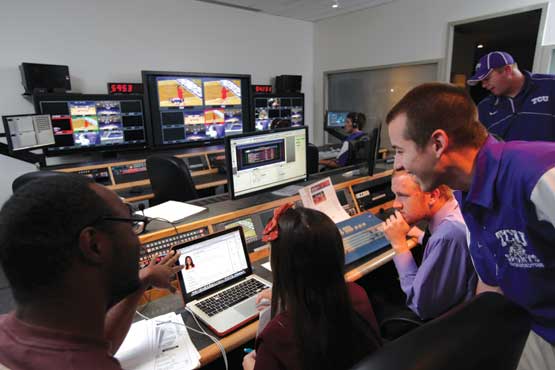Game on: Sports broadcasting
Film-Television-Digital Media Department’s sports broadcasting program has new HD equipment as part of $2.6 million upgrade.

Students in the department of Film-Television-Digital Media operate new HD broadcasting equipment thanks to a $2.6 million upgrade. Below, Sophomore Colin Perry works the controls. (Photography by Carolyn Cruz)
Game on: Sports broadcasting
Film-Television-Digital Media Department’s sports broadcasting program has new HD equipment as part of $2.6 million upgrade.
TCU athletes aren’t the only ones stepping up their game in a new conference. Sports broadcasting students now have the chance to produce nationally televised Big 12 conference games in high-definition, thanks to a $2.6 million equipment upgrade funded by TCU’s athletics department and the College of Communication.
The new equipment includes six HD video cameras with long lenses that students in the Film-Television-Digital Media (FTDM) department’s sports broadcasting program will use to produce home conference games in all sports except football on Fox Sports Southwest and the new Frog Vision online channel. In past years, FTDM students used standard-definition video equipment to produce content for the Mountain West Conference’s now-defunct cable network. Fox Sports requires all student-produced content to be filmed in HD. But the hefty price tag for replacing the old equipment was too much for the FTDM department to handle on its own, says Chuck LaMendola, assistant professor of professional practice and head of the sports broadcasting program.
“What is really remarkable about this is the synergy between academics and athletics,” LaMendola says. “This isn’t the case at a lot of schools. This is a testament to TCU for making a commitment of this magnitude and everyone involved who allowed it to happen.”
 Sports broadcasting students will work on roughly 160 nationally-televised events by the time they graduate. And they’ll do the work using industry-standard practices and programs. The HD cameras, combined with top-notch editing equipment, puts the FTDM’s Moudy Building quarters on par with the best professional broadcasting facilities in the Metroplex — and maybe the country, LaMendola says.
Sports broadcasting students will work on roughly 160 nationally-televised events by the time they graduate. And they’ll do the work using industry-standard practices and programs. The HD cameras, combined with top-notch editing equipment, puts the FTDM’s Moudy Building quarters on par with the best professional broadcasting facilities in the Metroplex — and maybe the country, LaMendola says.
“We’ve always striven to make sure that what our students use is the equipment that’s used across the industry,” LaMendola says. “It makes our students more marketable to top employers.”
During the semester, FTDM Assistant Professors Michael Martin and Andy Haskett got a lengthy crash course on the new equipment to make sure they understood all the intricate features before training students.
“There were a lot of similarities to the old equipment, but some fairly significant differences, too,” LaMendola says.
Now it’s the students’ turn. They produced HD content for the video boards at Amon G. Carter Stadium during football games and kicked off their sporting-event production in November with the broadcast of a TCU women’s basketball game.
Sports Broadcasting Board of Advisors
Jean Palmer-Savigny ’96
Manager of Remote Operations SportsNet, New York
Lance Barrow
Senior Producer
CBS Sports, New York
Reid Ryan ’95
President
Ryan-Saunders Baseball and Owners
of Round Rock Express and Corpus Christi Hooks
Missy Moore ’96
Producer, San Diego Padres
Pre/Post game show
Anthony Oppermann ’04
Director of Broadcasting
Redding Phillies
John Blake
Executive Vice-President
Texas Rangers
Mike Ryan
Senior Program Director
ESPN, Bristol, Conn.

Your comments are welcome
Comments
Related Reading:
Campus News: Alma Matters
From Application to Admission
Amid an increasingly selective admission process, Heath Einstein leads the team that builds the TCU community of the future.
Campus News: Alma Matters
From the Chancellor
Chancellor Victor J. Boschini, Jr., identifies what made TCU and its sesquicentennial so memorable.